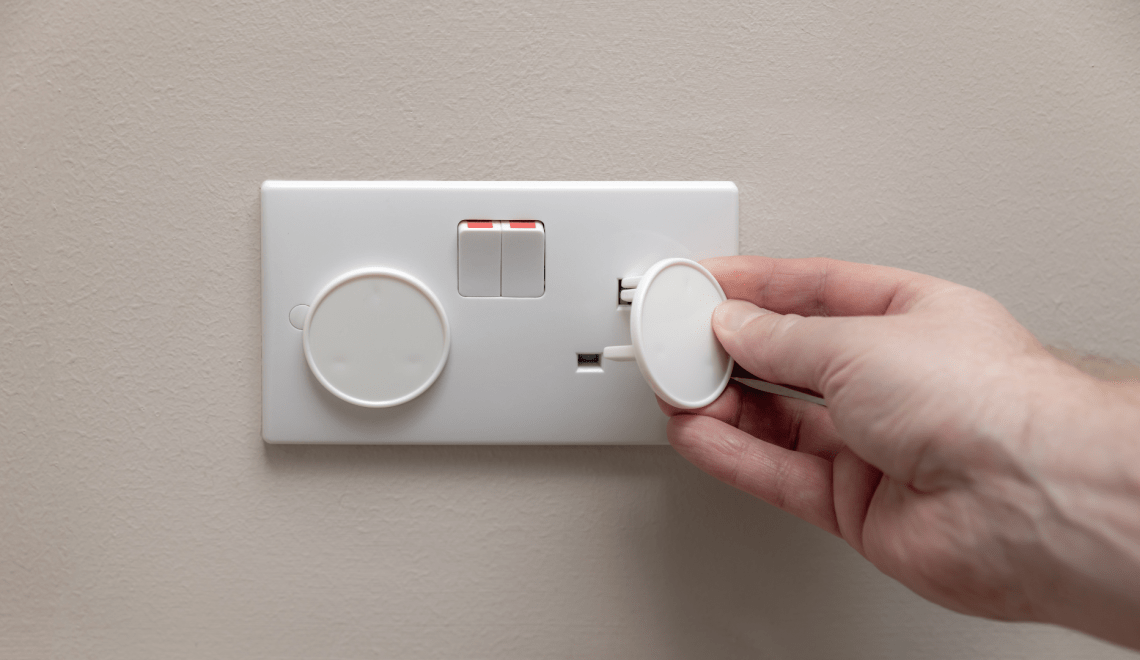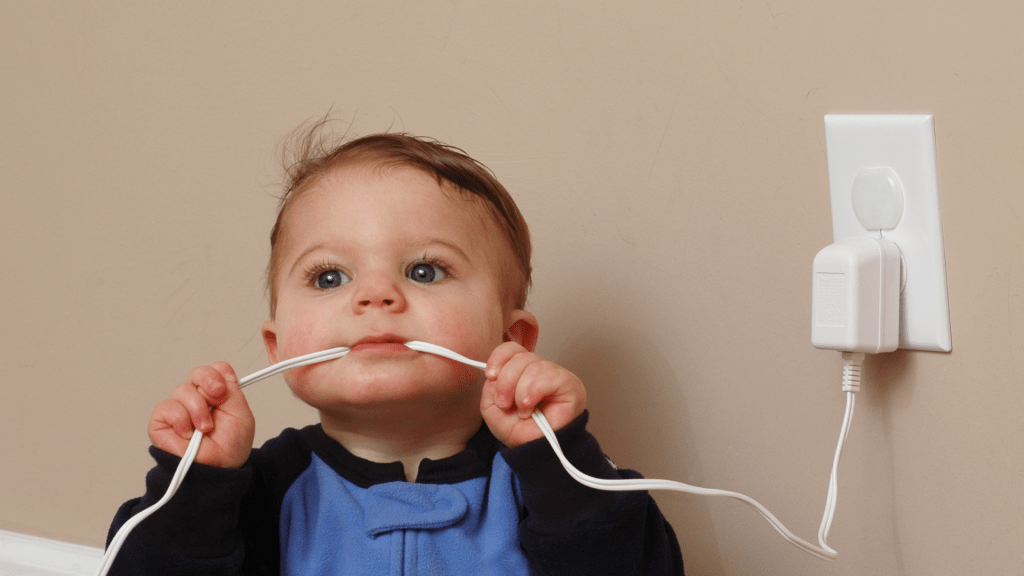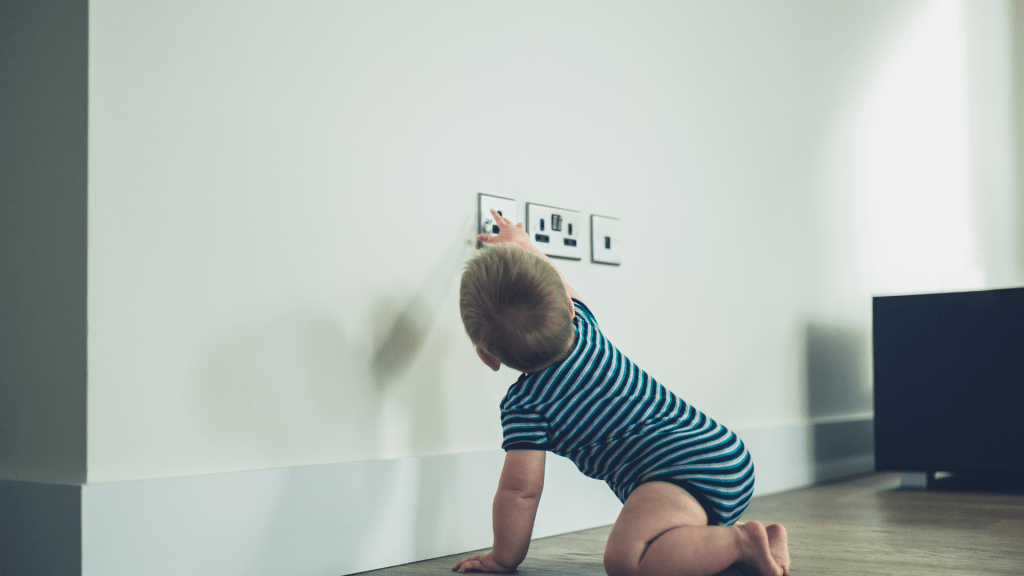
When you’ve got little ones running around the house, it doesn’t take long to realise just how many everyday objects can turn into potential hazards. From sharp corners to unattended cleaning products, parents quickly learn to think like their toddlers—curious, energetic, and entirely unaware of danger.
Among the most serious threats lurking in plain sight are your home’s electrical systems.
Electricity powers everything in your home, but without proper precautions, it can also pose significant risks to children. According to After Hours Electrical: “10-15% of injuries are caused by used and unused electrical outlets”.
Taking time to childproof your home’s electrical setup can give you peace of mind and help ensure your home remains a safe space for exploration and play.
Here’s a step-by-step guide to making your home’s electrical systems child-safe.
1. Cover All Power Points and Outlets
One of the first things babies learn to do is reach for objects at eye level—or in this case, knee level. Power points are especially tempting for curious toddlers, thanks to their shape and placement.
What you can do:
- Use outlet covers or socket plugs: These are inexpensive plastic inserts that prevent children from sticking their fingers or objects into the socket.
- For added security, consider tamper-resistant power points which only open when equal pressure is applied to both sides—something small children can’t easily do.
In newer Australian homes, some safety regulations already include childproof outlets, but it’s still worth double-checking, especially if your home was built before the 2000s.
2. Secure Electrical Cords
Loose cords can be both a strangulation hazard and a trip hazard. Worse still, children may chew on cords—particularly during teething phases—which could lead to electric shock.
What you can do:
- Use cord shorteners or cord winders to minimise slack.
- Keep cords tucked behind furniture where possible.
- Invest in cord covers that stick to walls or floors, keeping cords neatly out of reach.
- For hanging cords (like from blinds or appliances), use cord cleats or tie them up and secure them above a child’s reach.
Avoid running cords under rugs, as this can create a fire hazard due to overheating.
3. Unplug When Not in Use
A plugged-in appliance—even if turned off—still presents a risk. Curious toddlers may tug at cords or switch them on by accident.
What you can do:
- Get into the habit of unplugging devices like hairdryers, kettles, phone chargers, and toasters when not in use.
- Store them in locked or high cupboards where children can’t access them.
For devices that stay plugged in (such as TVs), consider using plug lock boxes to cover the entire plug and socket.
4. Hide or Block Off Power Boards
Power boards can be particularly tempting for little fingers with their rows of switches and lights. They’re also often within reach on the floor or under desks.
What you can do:
- Use power board covers that enclose the entire unit.
- Position power boards behind furniture where they’re not easily accessible.
- Avoid overloading power boards—especially if they’re accessible—since they can heat up or even spark if misused.
5. Use Safety Switches (RCDs)
Every Australian home should be fitted with residual current devices (RCDs)—also known as safety switches. These devices cut power almost instantly if they detect an imbalance, significantly reducing the risk of serious shock.
What you can do:
- Make sure your switchboard has RCD protection for all circuits.
- If not, get a licensed electrician to install them.
- You can also use portable RCDs for additional protection when using outdoor power tools or temporary devices.
Check RCDs monthly by pressing the “test” button. If the switch doesn’t flick off, call an electrician immediately.
6. Keep Appliances Out of Reach
Beyond power points and cords, the appliances themselves are a source of risk. Anything with heating elements—irons, heaters, toasters—can cause burns or start fires if mishandled.
What you can do:
- Place small appliances well out of reach and away from bench edges.
- Avoid leaving appliances near water sources like sinks or bathtubs.
- Keep bathroom items like hair dryers and electric razors unplugged and locked away.
Never leave a child unsupervised near a running appliance—especially heaters or fans with exposed elements.
7. Educate (and Supervise!) as Early as Possible
While physical safeguards are essential, teaching your child about electricity is also crucial. Depending on their age, children can begin to understand that some things are “not for touching.”
What you can do:
- Use simple language: “This is dangerous. Only adults touch it.”
- Be consistent in reinforcing boundaries around electrical items.
- As they grow older, explain how electricity works and why it must be respected.
Supervision remains key. Even in the most childproofed homes, there’s no substitute for a watchful eye.
8. Get a Professional Safety Inspection
If you’ve moved into a new home or live in an older property, it’s wise to have a licensed electrician conduct a safety audit. This will identify outdated wiring, faulty power points, or areas lacking RCD protection.
In Australia, licensed electricians are legally required for any electrical repairs or installations—DIY fixes are illegal and unsafe.
Smart Electrical Safety Starts at Home
If you’ve got little ones running around, sorting out your home’s electrical safety should be high on the list. It doesn’t take much—just a few tweaks here and there. And it’s worth it.
Around 15 people die every year in Australia because of preventable electrical accidents at home.
That number might sound small, but when you think about how easily some of those incidents could’ve been avoided, it hits differently.
Most of the fixes don’t cost much. Plug in some outlet covers, tidy up cords, maybe get a safety check done. Nothing fancy—just common sense stuff.
You’re not trying to make the house look like a padded cell. You just want to make sure your kids can explore and play without you stressing every time they go near a socket.
So have a quick look around. A few small changes now could save you from a massive headache later.









